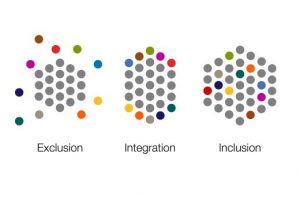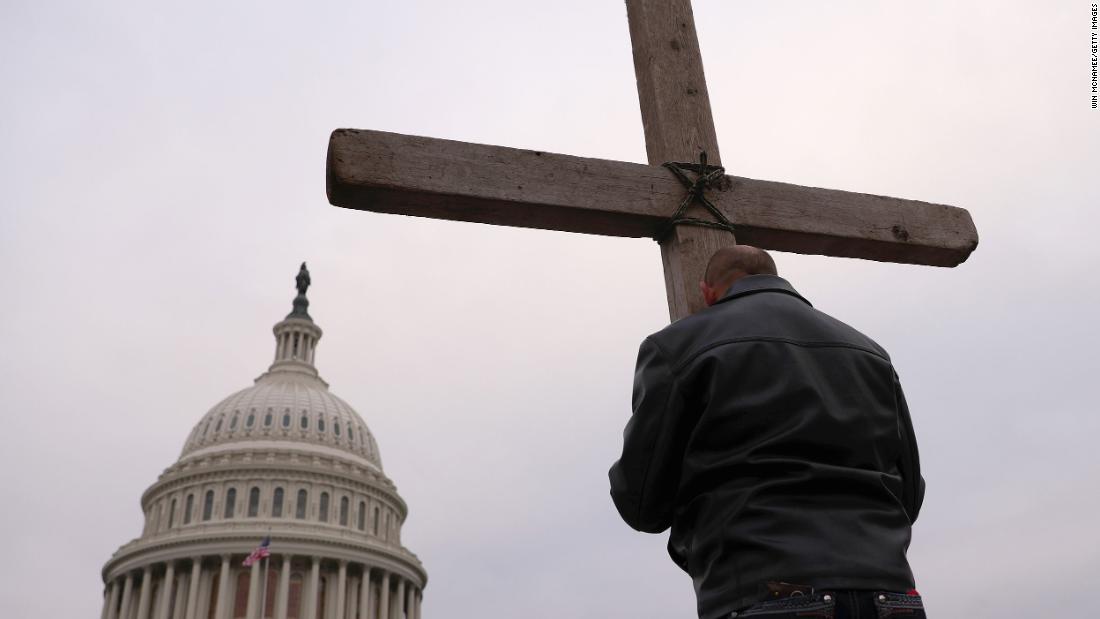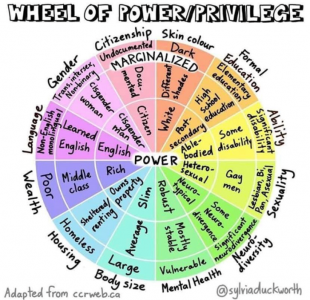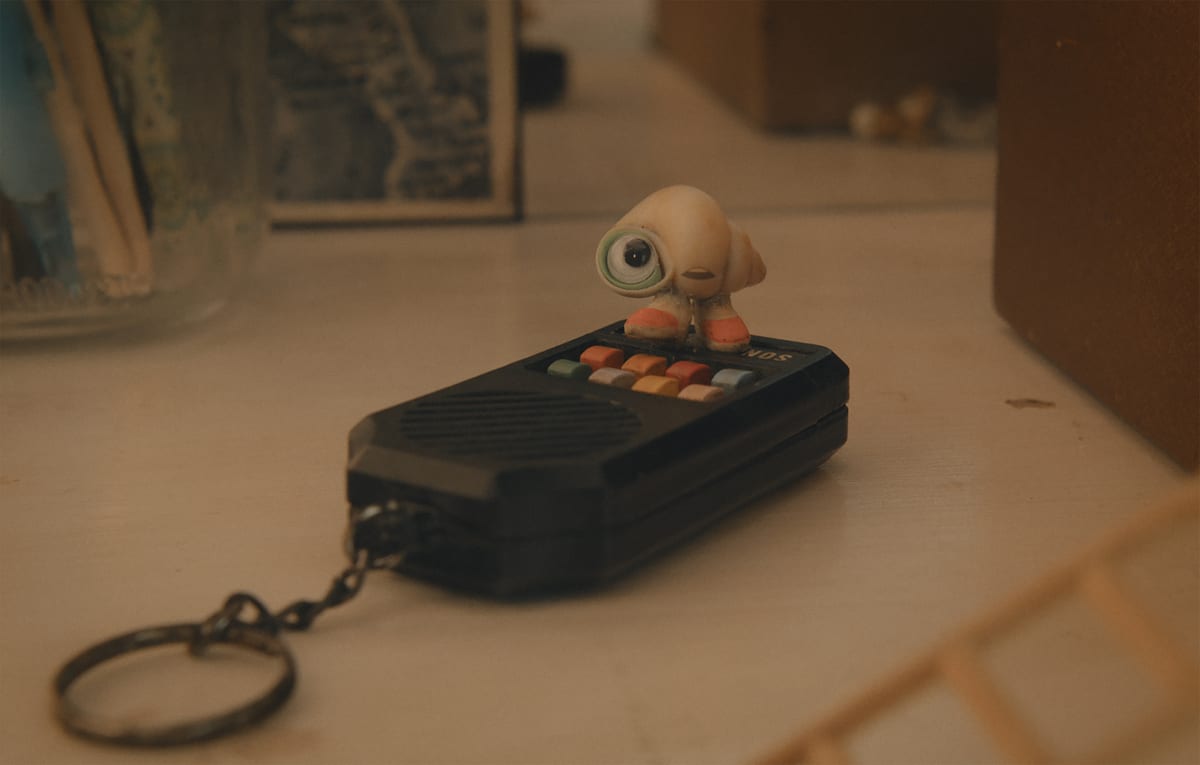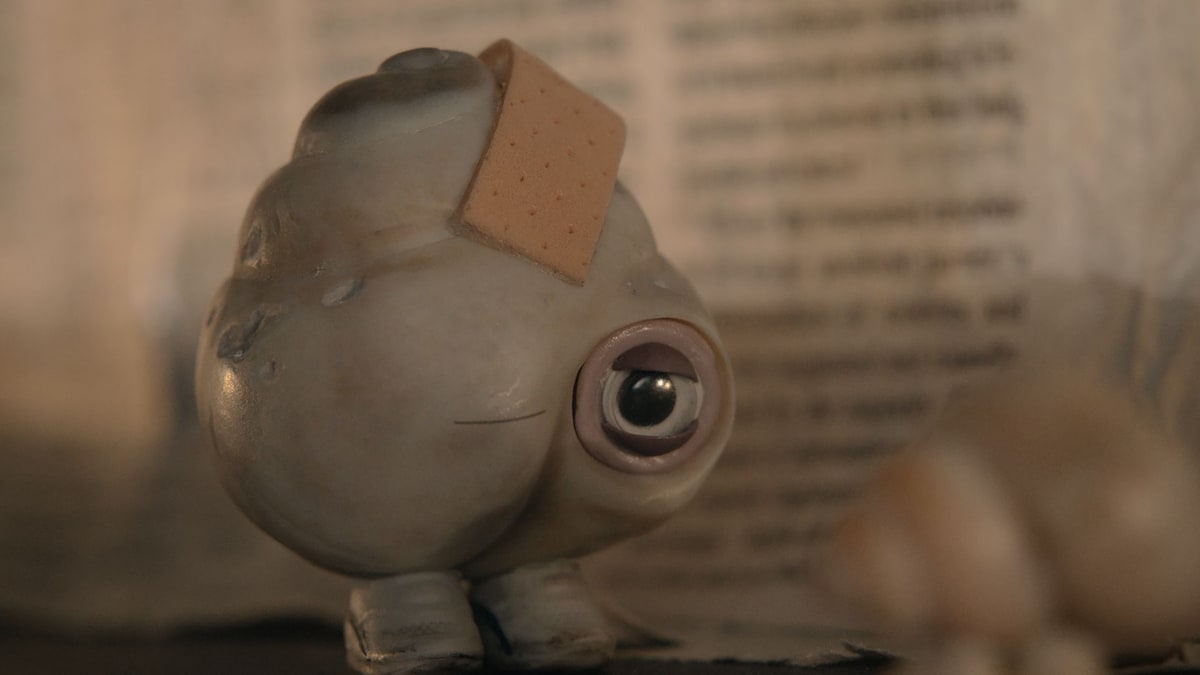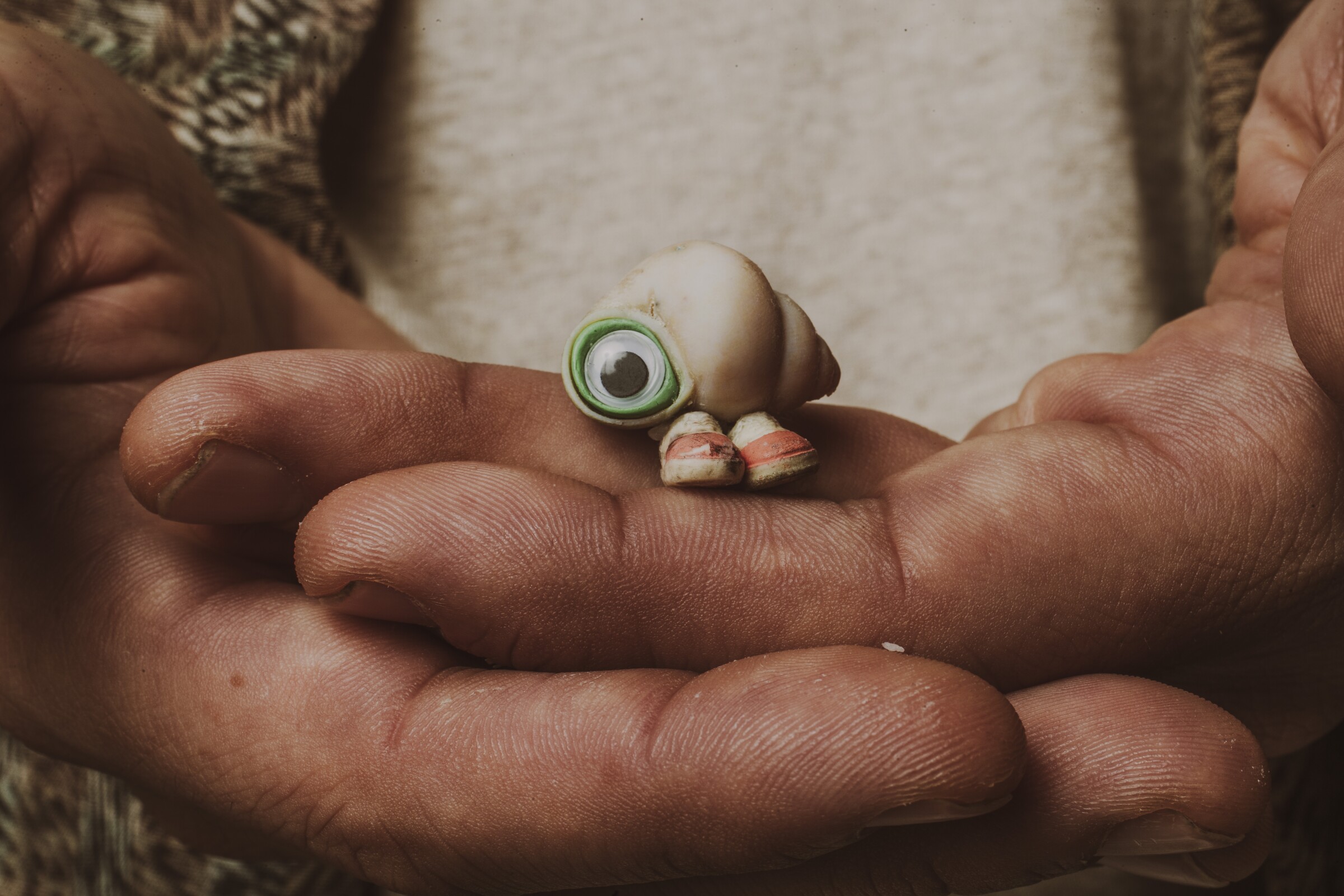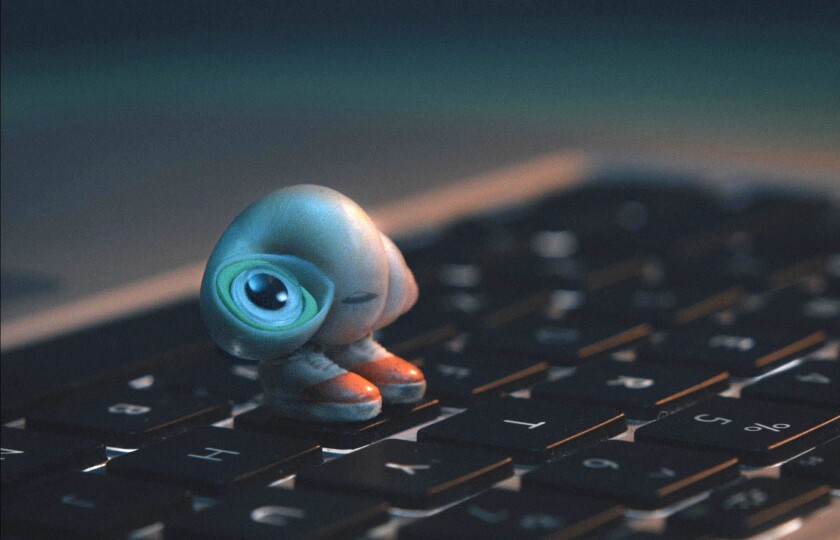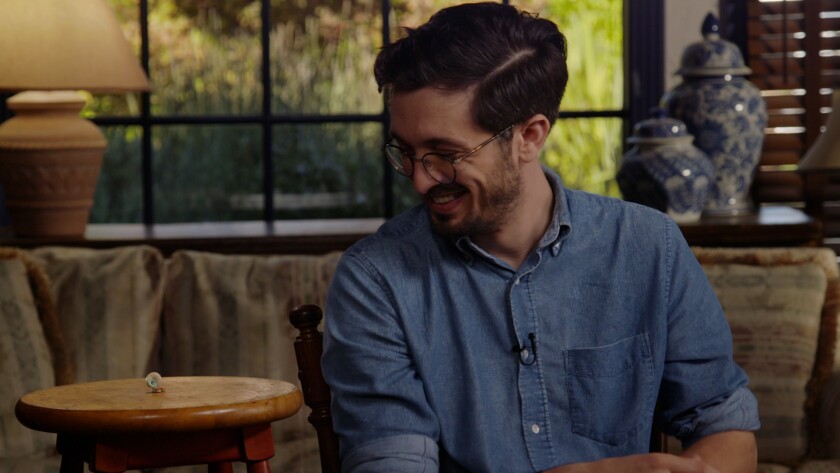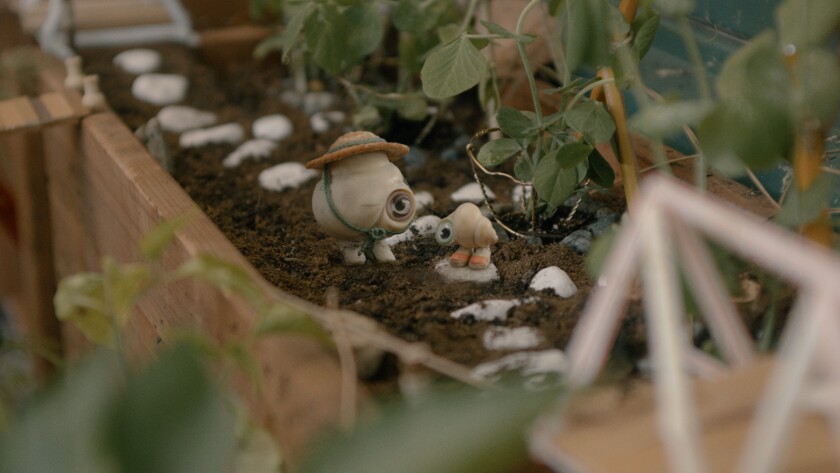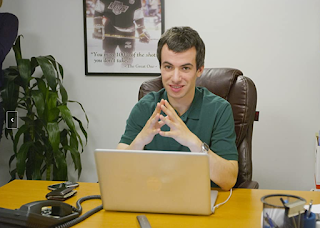An 'imposter Christianity' is threatening
American democracy
Sun July 24, 2022
(CNN)Three men, eyes closed and heads bowed, pray before a rough-hewn wooden cross. Another man wraps his arms around a massive Bible pressed against his chest like a shield. All throughout the crowd, people wave "Jesus Saves" banners and pump their fists toward the sky.
At first glance, these snapshots look like scenes from an outdoor church rally. But this event wasn't a revival; it was what some call a Christian revolt. These were photos of people who stormed the US Capitol on January 6, 2021, during an attempt to overturn the results of the 2020 presidential election.
The insurrection marked the first time many Americans realized the US is facing a burgeoning White Christian nationalist movement. This movement uses Christian language to cloak sexism and hostility to Black people and non-White immigrants in its quest to create a White Christian America.
A report from a team of clergy, scholars and advocates — sponsored by two groups that advocate for the separation of church and state — concluded that this ideology was used to "bolster, justify and intensify" the attack on the US Capitol.
 |
| Demonstrators pray outside the US Capitol in Washington on January 6, 2021. |
Much of the House January 6 committee's focus so far has been on right-wing extremist groups. But there are plenty of other Americans who have adopted teachings of the White Christian nationalists who stormed the Capitol — often without knowing it, scholars, historians, sociologists and clergy say.
"These ideas are so widespread that any individual pastor or Christian leader who tries to turn the tide and say, 'Let's look again at Jesus and scripture,' are going to be tossed aside," she says.
The ideas are also insidious because many sound like expressions of Christian piety or harmless references to US history. But White Christian nationalists interpret these ideas in ways that are potentially violent and heretical. Their movement is not only anti-democratic, it contradicts the life and teachings of Jesus, some clergy, scholars and historians say.
Here are three key beliefs often tied to White Christian nationalism.
A belief that the US was founded as a Christian nation
One of the banners spotted at the January 6 insurrection was a replica of the American flag with the caption, "Jesus is My Savior, Trump is My President."
Erasing the line separating piety from politics is a key characteristic of White Christian nationalism. Many want to reduce or erase the separation of church and state, say those who study the movement.
One of the most popular beliefs among White Christian nationalists is that the US was founded as a Christian nation; the Founding Fathers were all orthodox, evangelical Christians; and God has chosen the US for a special role in history.
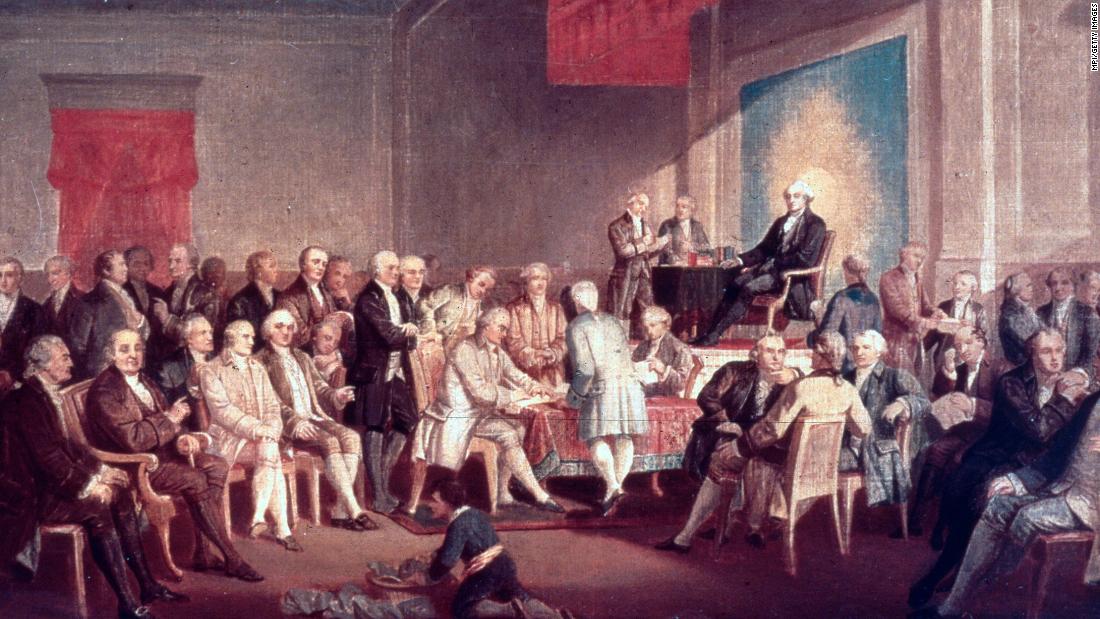 |
| This painting chronicles lawmakers' signing of the Constitution of the United States in 1787. |
These beliefs are growing among Christians, according to a survey last year by the Barna Group, a company that conducts surveys about faith and culture for communities of faith and nonprofits. The group found that an "increasing number of American Christians believe strongly" that the US is a Christian nation, has not oppressed minorities, and has been chosen by God to lead the world.
"It's a half truth, a mythological version of American history," Gorski says.
Some Founding Fathers did view the founding of the nation through a Biblical lens, Gorski says. (Every state constitution contains a reference to God or the divine.) But many did not. And virtually none of them could be classified as evangelical Christians. They were a collection of atheists, Unitarians, Deists, and liberal Protestants and other denominations.
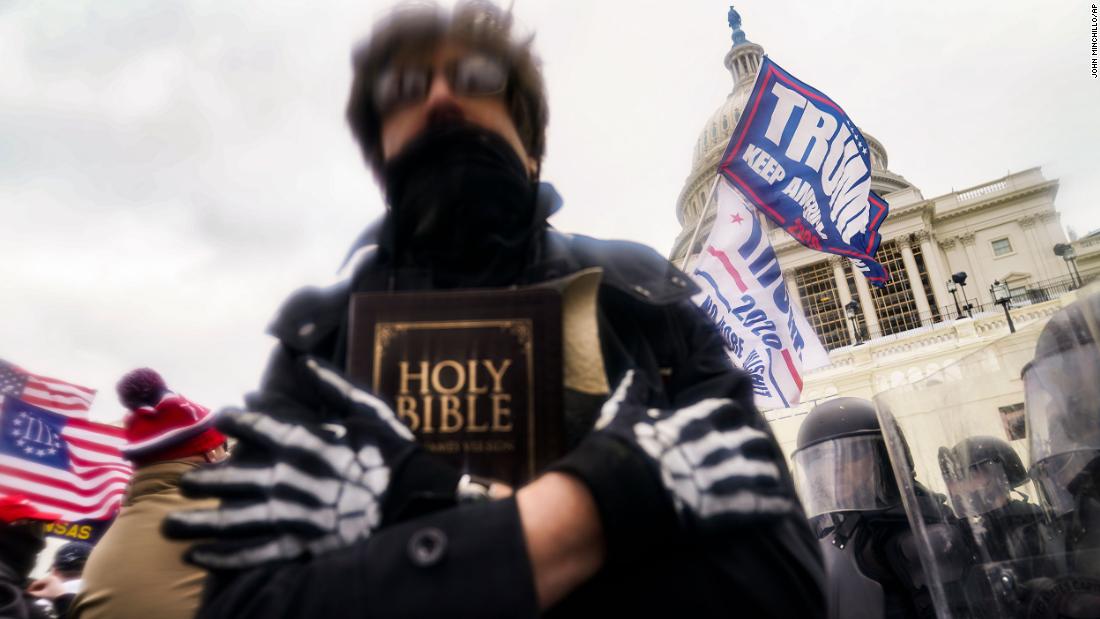 |
A Trump supporter holds a Bible as he gathers with
others outside the US Capitol on January 6, 2021. |
The Constitution also says nothing about God, the Bible or the Ten Commandments, Gorski says. And saying the US was founded as a Christian nation ignores the fact that much of its initial wealth was derived from slave labor and land stolen from Native Americans, he says.
For evidence that the United States was founded as a secular nation, look no further than the 1797 Treaty of Tripoli, an agreement the US negotiated with a country in present-day Libya to end the practice of pirates attacking American ships. It was ratified unanimously by a Senate still half-filled with signers of the Constitution and declared, "the Government of the United States of America is not, in any sense, founded on Christian religion."
Does this mean that any White Christian who salutes the flag and says they love their country is a Christian nationalist? No, not at all, historians say. A White Christian who says they love America and its values and institutions is not the same thing as a White Christian nationalist, scholars say.
Gorski also notes that many devout Black Americans have exhibited a form of patriotism that does not degenerate into Christian nationalism.
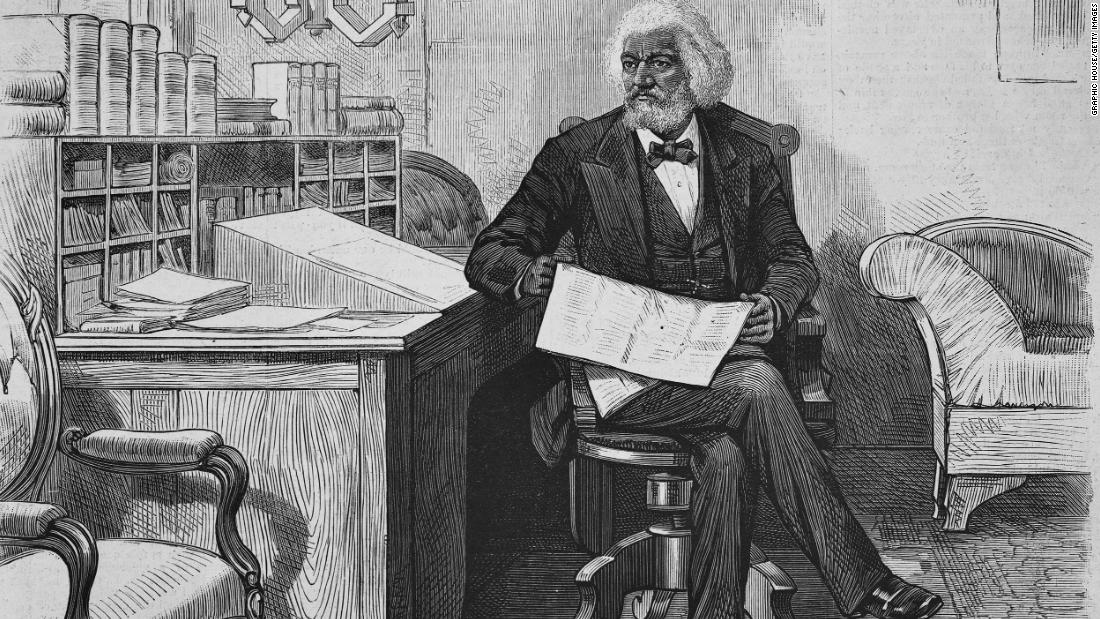 |
| American social reformer and abolitionist Frederick Douglass, circa 1880. |
Gorski points to examples of the 19th century abolitionist, Frederick Douglass, and the Rev. Martin Luther King, Jr. Both were devout Christians who expressed admiration for America and its founding documents. But their patriotism also meant that "they challenged the nation to live up to its highest principles, to become a place of freedom, equality, justice and inclusion," he says.
The patriotism of White Christian nationalists, on the other hand, is a form of racial tribalism, Gorski says.
"It's a 'My tribe. 'We [White people] were here first. This is our country, and we don't like people who are trying to change it or people who are different' form of nationalism," Gorski says.
A belief in a 'Warrior Christ'
Videos from the January 6 attack show a chaotic, tear-gas-soaked scene at the Capitol that looked more like a medieval battle. Insurrectionists punched police officers, used flagpoles as spears and smashed officers' faces against doors while a mob chanted, "Fight for Trump!" The attack left five people dead and nearly 140 law enforcement officers injured.
The incongruity of people carrying "Jesus Saves" signs while joining a mob whose members are pummeling police officers leads to an obvious question: How can White Christian nationalists who claim to follow Jesus, the "Prince of Peace" who renounced violence in the Gospels, support a violent insurrection?
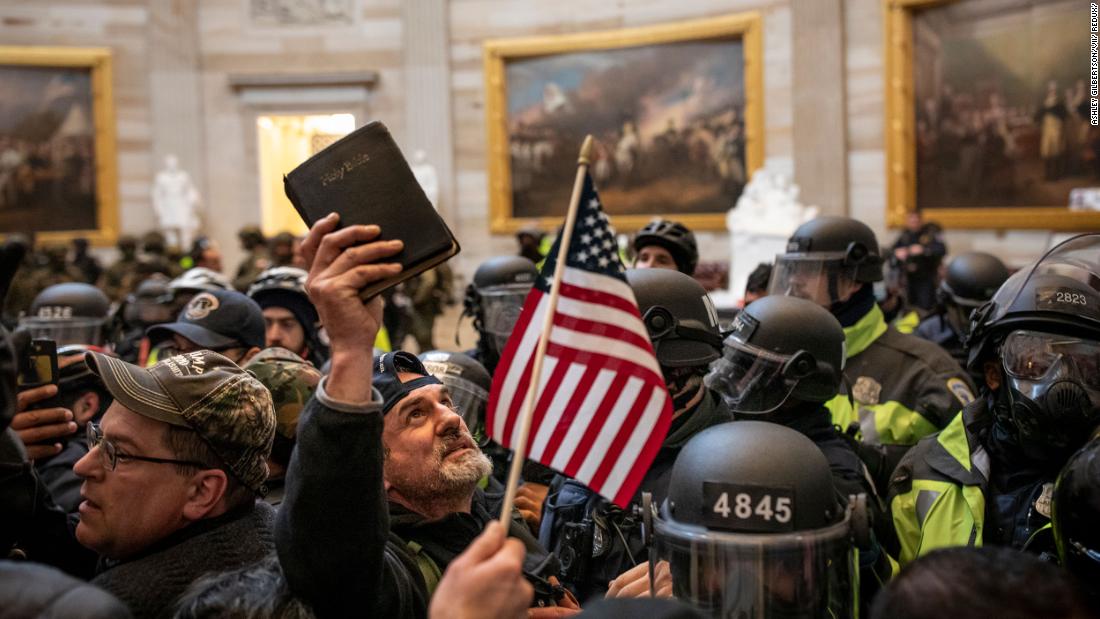 |
A protester holds up a Bible amid the crowd storming the
US Capitol Rotunda in Washington on January 6, 2021. |
That's because they follow a different Jesus than the one depicted in the Gospels, says Du Mez, who is also a professor of history and gender studies at Calvin University — a Christian school — in Michigan. They follow the Jesus depicted in the Book of Revelation, the warrior with eyes like "flames of fire" and "a robe dipped in blood" who led the armies of heaven on white horses in a final, triumphant battle against the forces of the antichrist.
White Christian nationalists have refashioned Jesus into a kick-butt savior who is willing to smite enemies to restore America to a Christian nation by force, if necessary, Du Mez and others say.
While warlike language like putting on "the full armor of God" has long been common in Christian sermons and hymns, it has largely been interpreted as metaphorical. But many White Christian nationalists take that language literally.
Read more from John Blake:
That was clear on January 6. Some insurrectionists wore caps emblazoned with "God, Guns, Trump" and chanted that the blood of Jesus was washing Congress clean. One wrote "In God We Trust" on a set of gallows erected at the Capitol.
"They want the warrior Christ who wields a bloody sword and defeats his enemies," says Du Mez. "They want to battle with that Jesus. That Jesus brings peace, but only after he slays his enemies."
And that Jesus sanctions the use of righteous violence if a government opposes God, she says.
"If you deem somebody in power to be working against the goals of a Christian America, then you should not submit to that authority and you should displace that authority," she says. "Because the stakes are so high, the ends justify the means."
 |
Supporters of then-President Donald Trump gather on the Ellipse
near the White House to hear him speak on January 6, 2021. |
That ends-justify-the means approach is a key part of White Christian nationalism, says Du Mez. It's why so many rallied behind former President Trump on January 6. She says he embodies a "militant White masculinity" that condones callous displays of power and appeals to Christian nationalists.
But with few exceptions, White Christian nationalists do not accept this "militant masculinity" when exhibited by Black, Middle Eastern and Latino men, Du Mez writes in "Jesus and John Wayne." Aggression by people of color "is seen as a threat to the stability of home and nation," she writes.
Wisconsin Republican Senator Ron Johnson echoed this double standard last year when he said on a radio talk show that he never really felt threatened by the mostly White mob that stormed the Capitol on January 6.
"Now, had ... President Trump won the election and those were tens of thousands of Black Lives Matter and Antifa protesters, I might have been a little concerned," Johnson said.
Johnson later elaborated, saying "there was nothing racial about my comments-- nothing whatsoever."
This embrace of a warrior Christ has shaped some White evangelicals' attitudes on issues ranging from political violence to gun safety laws.
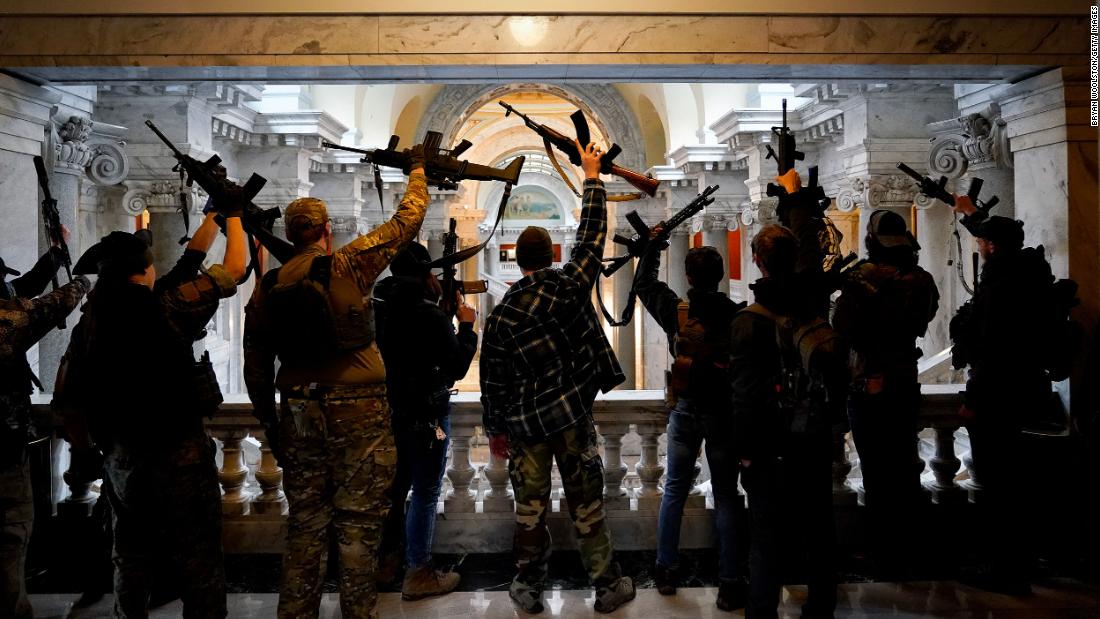 |
Gun rights activists carrying semi-automatic firearms pose for a photograph
in the state Capitol Building on January 31, 2020, in Frankfort, Kentucky. |
Samuel Perry, co-author of "Taking America Back for God: Christian Nationalism in the United States," wrote in a recent essay that among Americans surveyed who believe "The federal government should declare the United States a Christian nation," over two-thirds rejected the idea that the federal government should enact stricter gun laws."
"The more you line up with Christian nationalism, the less likely you are to support gun control," wrote Perry. "Guns are practically an element of worship in the church of white Christian nationalism."
A belief there's such a person as a 'real American'
In the 2008 presidential election, vice presidential candidate Sarah Palin introduced a new term to the political discourse. She talked about "the real America" and the "pro-America areas of this great nation." Since then, many conservative political candidates have used the term "real Americans" to draw contrasts between their supporters and their opposition.
Such language has been co-opted into a worldview held by many White Christian nationalists: The nation is divided between "real Americans" and other citizens who don't deserve the same rights, experts on White Christian nationalism say.
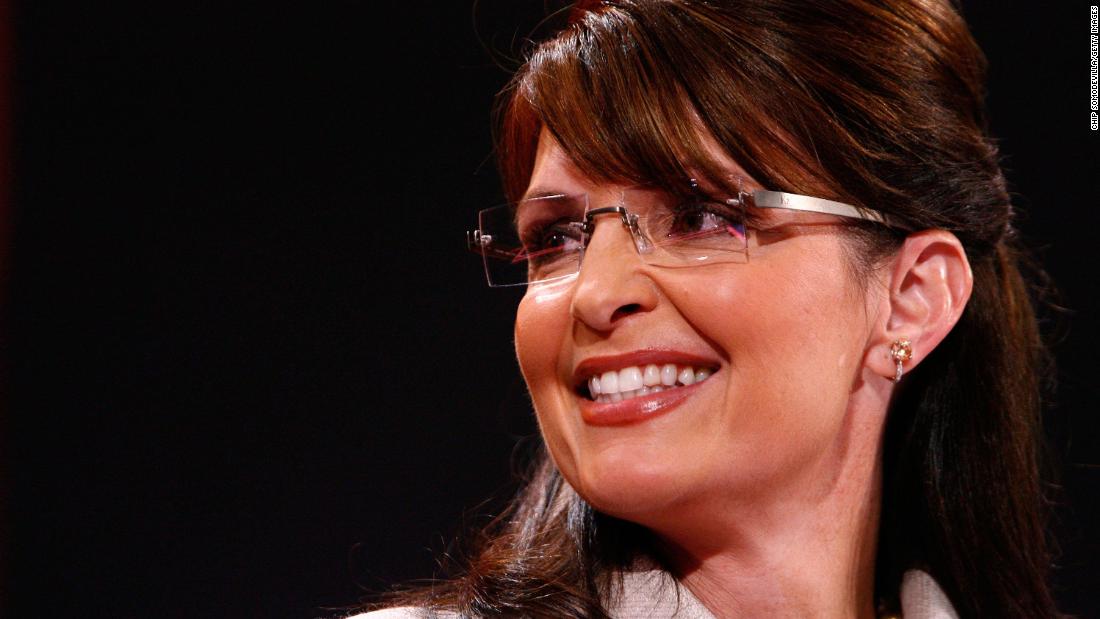 |
Republican vice presidential nominee Alaska Gov. Sarah Palin speaks
at the 2008 Republican National Convention in St. Paul, Minnesota. |
Gorski, author of "The Flag and the Cross," says he found in his research a strong correlation between White Christian nationalism and support for gerrymandering—an electoral process where politicians manipulate district lines to favor one party or, some critics say, race over another. He found similar support among White Christian nationalists for the Electoral College, which gives disproportionate political power to many rural, largely White areas of the country.
When White Christian nationalists claim an election was stolen, they are reflecting the belief that some votes don't count, he says.
"It's the idea that we are the people, and our vote should count, and you're not the people, and... you don't really deserve to have a voice," Gorski says. "It doesn't matter what the voting machines say, because we know that all real Americans voted for Donald Trump."
Why White Christian nationalism is a threat to democracy
Those who want the US to become a Christian nation face a huge obstacle: Most Americans don't subscribe to their vision of America.
The mainstreaming of White Christian nationalism comes as a growing number of Americans are rejecting organized religion. For the first time in the US last year, membership in communities of worship fell below 50%. Belief in God is at an all-time low, according to a recent Gallup poll.
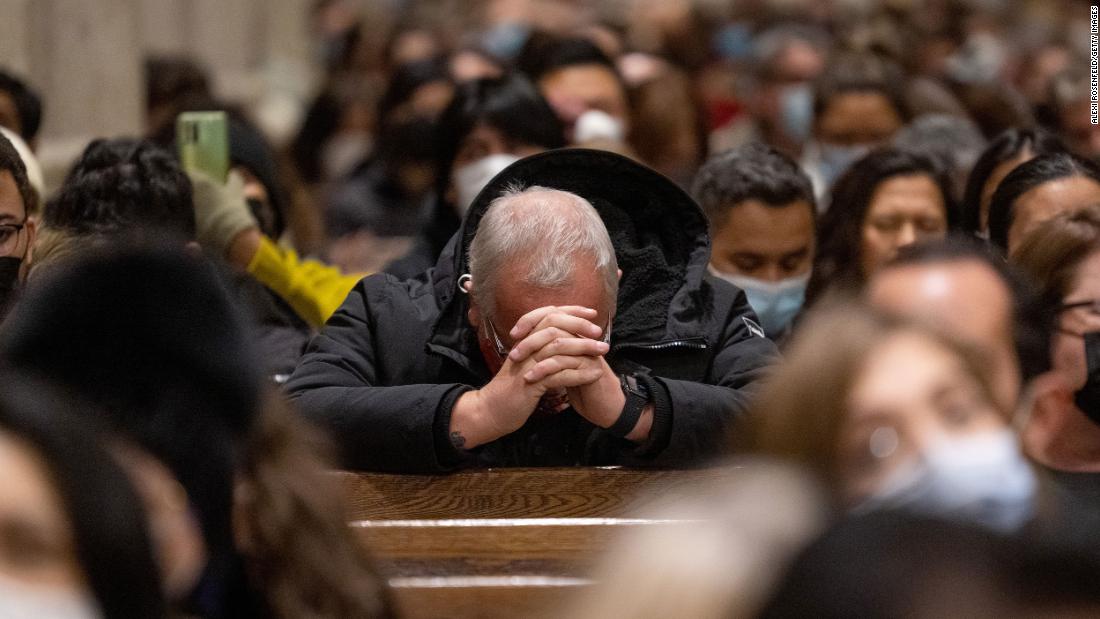 |
A parishioner bows his head to pray while celebrating midnight Mass
at St. Patrick's Cathedral on December 24, 2021, in New York City. |
Add to that the country's growing racial and religious diversity. People who identify as White alone declined for the first time since the census began in 1790, and the majority of Americans under 18 are now people of color.
On the surface, White Christian nationalism should not be on the ascent in America.
So White Christian nationalists look for salvation from two sources.
One is the emboldened conservative majority on the US Supreme Court, where recent decisions overturning Roe vs. Wade and protecting school prayer offer them hope.
Not all Christians who support the high court's overturning of Roe v. Wade and its school prayer decision are White nationalists. For example, plenty of Roman Catholics of all races support racial justice yet also backed the overturning of Roe.
But White Christian nationalists are inspired by those decisions because one of their central goals is to erase the separation of church and state in the US.
A recent study concluded that five of the justices on the Supreme Court are the "most pro-religion since at least World War II," and that the six conservative justices are "all Christian, mostly Catholic," and "religiously devout."
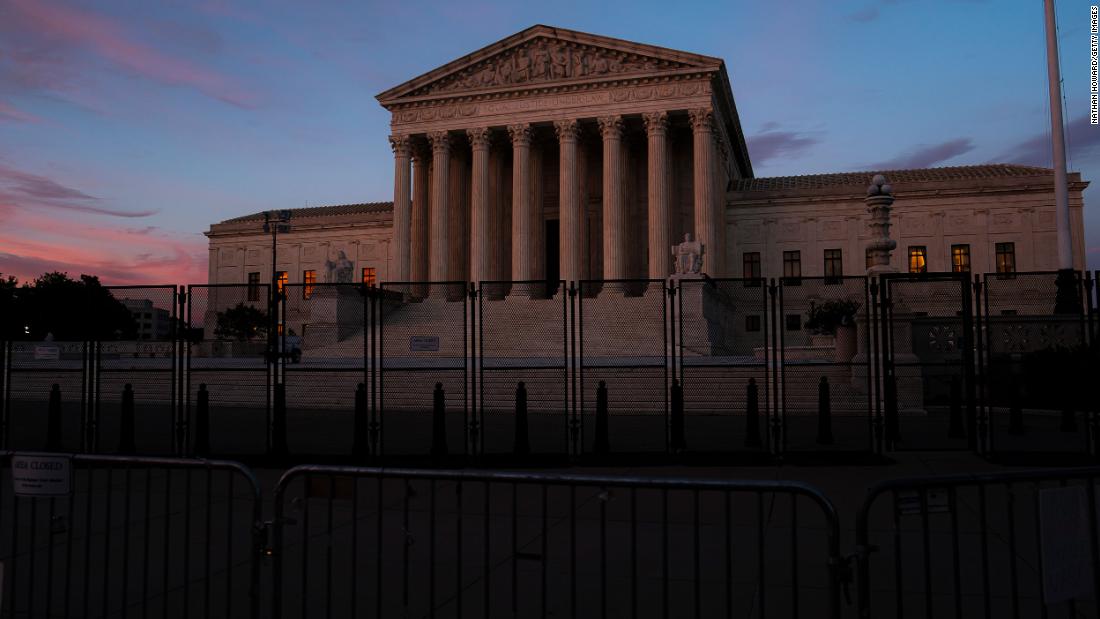 |
The sun sets in front of the Supreme Court on June 28, 2022, in Washington.
A Supreme Court decision last month overturned the landmark
Roe v. Wade ruling and erased a federal right to an abortion. |
While some Americans fear the dangers of one-party rule, others like Pamela Paul, a columnist, warn of the Supreme Court instituting one-religion rule.
Gorski, the historian, says White Christian nationalism represents a grave threat to democracy because it defines "we the people" in a way that excludes many Americans.
"The United States cannot be both a truly multiracial democracy -- a people of people and a nation of nations -- and a white Christian nation at the same time," Gorski wrote in "The Flag and the Cross." "This is why white Christian nationalism has become a serious threat to American democracy, perhaps the most serious threat it now faces."
The other source of hope for White Christian nationalists is a former occupant of the White House. Their devotion to him is illustrated by one of most striking images from the January 6 insurrection: A sign depicting a Nordic-looking Jesus wearing a red "Make America Great Again" hat.
If Trump returns to the presidency, some White Christian nationalists may interpret his political resurrection as divine intervention. His support among White evangelicals increased from 2016 to 2020.
And what the men carrying wooden crosses among the Capitol mob couldn't achieve on January 6, they might yet accomplish in 2024.


